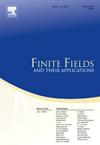Construction of Galois self-orthogonal MDS codes with larger dimensions
IF 1.2
3区 数学
Q1 MATHEMATICS
引用次数: 0
Abstract
Let be a prime power, e be an integer with and . In this paper, for a vector and a q-ary linear code , we give some necessary and sufficient conditions for the equivalent code of and the extended code of to be e-Galois self-orthogonal. We then directly obtain some necessary and sufficient conditions for (extended) generalized Reed-Solomon (GRS and EGRS) codes to be e-Galois self-orthogonal. From this we show that if , there is no e-Galois self-orthogonal (extended) GRS code. Furthermore, for all possible e satisfying , we classify them into three cases (1) odd and p even; (2) odd and p odd; (3) even, and construct several new classes of e-Galois self-orthogonal maximum distance separable (MDS) codes. It is worth noting that our e-Galois self-orthogonal MDS codes can have dimensions greater than , which are not covered by previously known ones. Moreover, by propagation rules, we obtain some new MDS codes with Galois hulls of arbitrary dimensions.
大维伽罗瓦自正交MDS码的构造
设q=pm为质数幂,e为0≤e≤m−1的整数,s=gcd (e,m)。本文针对向量v∈(Fq)n和一个q元线性码C,给出了C的等价码Φv(C)和扩展码Φv(C)是e-伽罗瓦自正交的一些充要条件。然后直接得到了广义Reed-Solomon码(GRS和EGRS)是e-伽罗瓦自正交的一些充要条件。由此我们证明了如果k≥min (min) (max) (pe,≤n+pepe+1), (max) (pm−e,≤n+pm−epm−e+1)²}},不存在[n,k]q e-伽罗瓦自正交(扩展)GRS码。进一步,对于所有可能满足0≤e≤m−1的e,我们将它们分为三种情况(1)ms为奇数,p为偶数;(2) ms奇数和p奇数;(3)构造了几类新的e-伽罗瓦自正交最大距离可分离码(MDS)。值得注意的是,我们的e-伽罗瓦自正交MDS码的维数可以大于⌊n+pe−1pe+1⌋,这是以前已知的码所没有的。此外,根据传播规则,我们得到了一些新的具有任意维伽罗瓦壳的MDS码。
本文章由计算机程序翻译,如有差异,请以英文原文为准。
求助全文
约1分钟内获得全文
求助全文
来源期刊
CiteScore
2.00
自引率
20.00%
发文量
133
审稿时长
6-12 weeks
期刊介绍:
Finite Fields and Their Applications is a peer-reviewed technical journal publishing papers in finite field theory as well as in applications of finite fields. As a result of applications in a wide variety of areas, finite fields are increasingly important in several areas of mathematics, including linear and abstract algebra, number theory and algebraic geometry, as well as in computer science, statistics, information theory, and engineering.
For cohesion, and because so many applications rely on various theoretical properties of finite fields, it is essential that there be a core of high-quality papers on theoretical aspects. In addition, since much of the vitality of the area comes from computational problems, the journal publishes papers on computational aspects of finite fields as well as on algorithms and complexity of finite field-related methods.
The journal also publishes papers in various applications including, but not limited to, algebraic coding theory, cryptology, combinatorial design theory, pseudorandom number generation, and linear recurring sequences. There are other areas of application to be included, but the important point is that finite fields play a nontrivial role in the theory, application, or algorithm.

 求助内容:
求助内容: 应助结果提醒方式:
应助结果提醒方式:


